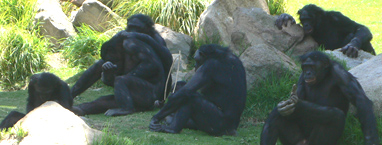
Primate Cognition
| How do animals think? |
Being animals ourselves, it is surely the case that our intellectual abilities are built on a foundation of animal cognition. In the winter of 1995, Cognition in the Wild had just come out and I was able to travel to Kenya to observe free-ranging olive baboons with Shirley Strum. For two weeks we adopted the routine of going out before dawn to find the baboons in their sleeping place, then following them until about mid-day. Shriley drew on her 25 years of experience studying those animals to provide a rich commentary on their activities and their cognitive lives. In the afternoons we would retreat to the research station where we would discuss the similarities (there were surprisingly many) and differences between the behavior of the baboons and the behavior of the humans described in Cognition in the Wild. These observations and discussions set the stage for more thinking about how the distributed cognition framework casts primate cognition in a new light. More recently, I have been deeply influenced by the work of my colleague, Christine Johnson, who studies cognition in marine mamals and in two groups of bonobos. Chris has done more than anyone else to follow through on the promise of applying the distributed cognition approach to the study of non-human animals. Publication: Strum, S. C., Forster, D., & Hutchins, E. (1997). Why Machiavellian intelligence may not be Machiavellian. In: Machiavellian intelligence II: Extensions and evaluations. A Whiten & RW Byrne (eds), Cambridge: Cambridge University Press, pp 50-85, 1997. Hutchins, E. The role of cultural practices in the emergence of modern human intelligence. Phil. Trans. R. Soc. B 363, 2011-2019. doi:10.1098/rstb.2008.0003. Hutchins, E. & Johnson, C. (in press) Modeling the emergence of language as an embodied collective cognitive activity. Topics in Cognitive Science. |